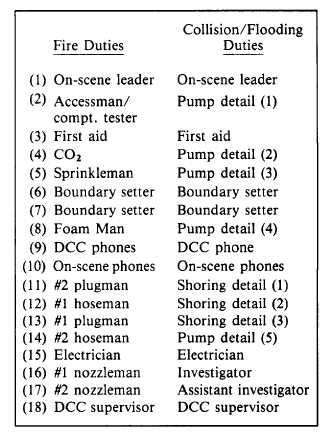Zebra has been set in assigned areas, each unit
will report “Zebra set” to the repair locker leader.
Each repair locker officer will compile “manned
and ready” and Zebra reports and report attain-
ment status to damage control central. In an
actual casualty immediate damage control action
may be necessary. In this case unit leaders should
report manned and ready as soon as possible.
REPAIR PARTY ORGANIZATION
FOR FIRE FIGHTING
Repair parties provide the only personnel
immediately available to fight fires during action.
Therefore, deciding upon a plan of action for
repair parties, before action, is essential.
All repair parties must be thoroughly
indoctrinated and properly trained to carry
out such plans of action. Valuable time would
be lost if the method of fire fighting was
not decided until the fire was actually underway.
No matter how well your people are trained
in the use of equipment, if they are not trained
to act as a team following definite plans,
confusion will result. This confusion may be
short lived, but it will interfere with fire-fighting
efforts.
Divide large repair parties into fire-fighting
groups. Where possible, organize at least two
groups or teams from each repair party. Train
these groups so any member can quickly under-
take any of the detailed duties as circumstances
warrant. Each team member should know the
correct starting position in the event of a fire,
flooding, or a major casualty as assigned by the
watch, quarter, and station (WQS) bill. Maximum
use of PQS will assist in training your teams to
be competent, flexible repair parties. Table 7-1
shows the minimum acceptable duty damage
control party assignments for fire and collision/
flooding duties.
BATTLE DRESSING STATIONS
Most ships have a minimum of two battle
dressing stations equipped for emergency handling
of battle casualties. These stations should be
well separated from each other and accessible to
stretcher bearers from repair parties in the vicinity.
These stations will be manned with medical
department personnel. The medical department
should also provide first-aid boxes for personnel
in battle stations.
Table 7-1.—Minimum Acceptable Duty Damage Control
Party
ON-SCENE LEADER
The on-scene leader takes charge of the repair
of damage at the immediate scene and is directly
in charge of the fire-fighting party. The first
duty of the on-scene leader is to get to the fire
or damage quickly to investigate and evaluate the
situation. When the nature of the fire or damage
has been determined, the on-scene leader informs
the repair party leader, who informs DCC. The
on-scene leader is responsible for directing efforts
to control the fire or damage at the scene. Later
developments may require the use of different or
additional equipment, but the on-scene leader
must decide what equipment to use first. The
on-scene leader must ensure that personnel
observe all safety precautions and standard
procedures in the performance of all phases of
damage control. The on-scene leader is the
assistant repair party leader and is in charge of
the repair locker in the absence of the repair
party leader. To be an on-scene leader, you should
be qualified in investigation, fire fighting, and
damage control repair.
7-7

